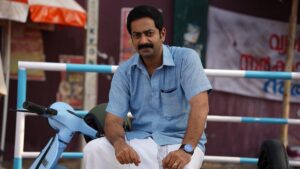Diljit Dosanjh at his best in masterfully crafted songs

Imtiaz Ali Amar Singh ChamkilaOpens with a violent death, masterfully crafted for the power of song and performance as a tool of rebellion. Bullet ended a music career and spawned an immortal legend.
The film embraces various conflicts. And why not? Amar Singh Chamkila It’s about a man whose art was dichotomous: entertaining and provocative, wildly popular and needlessly profane.
The film is mournful and celebratory, animated and thoughtful, consciously crafted and seemingly spontaneous. It’s a tribute and a celebration for a songwriter who unleashed lyrics that often objectified women but were always delivered in the form of a male-female duo.
Amar Singh Chamkila Mourns the loss of a young life but speaks of the defiant spirit of a driven man whose music, however lowly it may have been by orthodox and politically correct calculations, broke the bounds of death.
The film’s soundtrack is a complement of Chamkila’s own songs (inspired by lead actors Diljit Dosanjh and Parineeti Chopra, among many others) and AR Rahman’s original compositions, ranging from ballad-like and romantic to forcefully feminist.
Chamkila (played brilliantly by Dosanjh), his wife and co-singer Amarjot Kaur (Parineeti Chopra) and two gang members were gunned down by unidentified assailants in Mehsampur in Jalandhar district 36 years ago. That’s where the Netflix film started.
It then followed the immediate aftermath of the singer’s murder in broad daylight and career signposts that saw him and Amarjot blaze a trail in Punjab’s akhara (open-air folk music recital) landscape.
Screenplay with director Sajid Ali, Amar Singh Chamkila Captures a short life and an eventful career that teeters on a razor’s edge and gains strength from the ruffling of feathers.
The high-spirited music he created and his thumbi strains contained his message of liberation from social shackles, a statement of intent that imprinted itself permanently on people’s minds and ushered in an exciting new phase of Punjabi pop.
The film tracks Chamkila’s life and explores her unprecedented stardom. Dhani Ram alias Amar Singh was born into a poor alcoholic Dalit laborer’s family. The two names he took became prophetic.
By the time he was 17, he had achieved both wealth and immortality. Over the next ten years, he traveled the length and breadth of Punjab with his repertoire of songs. There was never a day when this popular singer was not on the road.
The biopic expands from the point of Chamkila’s accidental acquisition of her nom de plume and her initial struggle to find a suitable female singing partner to her mentor Jatinder Zinda (based on the real-life Surinder Zinda)’s swift and dramatic takeover.
Chamkila’s runaway success irritated his rivals and irritated the guardians of Punjab’s morals. Her inter-caste marriage to Amarjot – he a Jat, she a Ramdasia – puts her on a collision course with the village council.
During the height of militancy in the 1980s, his raucous, no-holds-barred, double-entendre-led songs helped his fans escape the anxiety of a violence-prone world. He sang about sexual desire, the female body, drugs, social taboos and illicit relations.
A journalist accused him, and not unreasonably, of being disrespectful to women. He protects himself. I am a common man, he says, who has no choice but to weigh the pros and cons.
There is a sequence in the film in which Chamkila mentions her caste and insists that wherever she emerged from, she will not go back. I will not starve, he insisted. The film, however, shies away from making his social identity the main narrative axis, focusing instead on his run-ins with the hypocrisies of polite society.
The Chamkila-Amarjot marriage crosses two lines – one marked by caste division and the other by her marital status. The singer has a first wife, a fact he hid from Tikki and Amarjot.
The story is originally told by Chamkila’s two surviving associates. Her former drummer and manager Kesar Singh Tikki (Anjum Batra) who drinks cheap alcohol at a seedy bar after learning of Chamkila’s death, reflects on the singer’s early success.
The latter half of the story is brought together by group member and singer Kikar Dalewala (Ravi Johal). Kicker reminisces in response to DSP Balbir Singh’s (Anurag Arora) questions. He taunts Kikar when he asks if he has ever heard Chamkila’s song. The police officer got angry and fired back: Am I a truck driver or a country bumpkin?
The film blends a vibrant palette, visual richness and playful tropes to transport the audience to the terrain where Chamkila appeared like a meteor in the sky and lit up the world around her so intensely that it would never fade. die alone
The grim narrative rhythm serves as a counterpoint to the grim reality of 1980s Punjab. An admirer in the audience waiting to hear his song: Other artists are great but you are our own man. Baaja (lyrics by Irshad Kamil) as an introductory song, he is a people’s singer, underscores the film’s opening.
For balance, the film stages a trippy number devoted entirely to female desire, the soft kalja, sung and merrily performed by village women who are deprived of seats in front of the stage where Chamkila performs. They stand on the back porch of the field and watch the performance.
The full-bodied and occasionally frolicsome style – it combines archival footage, family album images, freeze frames, animation, split screen, tinted frames and visual caesura – tries to approximate the wildness at the heart of Chamkila’s world, even if it slows down at times. Reflect on the singer’s soft-spoken, non-confrontational way with the people around him.
Diljit Dosanjh is the best as Chamkila. That, his fans will confirm, should be enough to make the film a treat. But there is more Amar Singh ChamkilaWith Parineeti Chopra and Anurag Arora’s combined interpretation and Imtiaz Ali’s grip on the material.
Amar Singh Chamkila A transfixing viewing experience. Its music is the biggest draw but the rest of the film pays off every bit.



